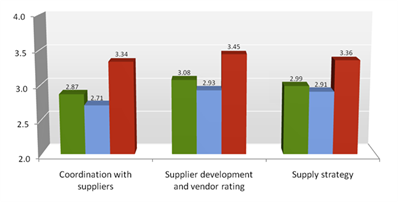Archive
Managing risk in supply chains: here is the right way!
In the last february, I posted an article that points out the importance to undertake supply chain risk management (SCRM) practices to deal with the fragility of upstream networks. However, one should be concern about the efficacy and the cost of these practices.
The question is … Are there drawbacks coming from their adoption? The answer is quite simple: YES, THERE ARE!
In this post we are going to shed some light on the dark side of SCRM. On the base of our research findings (Gualandris and Kalchschmidt, 2012), we suggest that managers should bear in mind an acceptable cost-benefit trade-off when setting the adoption of SCRM practices.
Supply network stability can be achieved by employing different risk management levers:
- Two (or more) vendors for each supply, one of which may dominate the others in terms of business share and performance. In this way companies reduce vendors’ moral hazard risk and in case of chain disruptions can effectively react supporting minor switching costs;
- Vendor rating programs that employ both operational and financial criteria enable companies to avoid adverse selection, anticipate undesirable events (e.g., suppliers’ failure), and motivate suppliers to a parsimonious conduct;
- Supplier development programs that can produces tangible benefits such as greater quality and flexibility, and more reliable deliveries;
- Revenue sharing contracts that allow to share risk and prescribe suppliers commitment.
The same practices, anyway, can produce negative impact on performance, both at the company level and at the supply chain level. Some examples below:
- Dual or multiple sourcing: on one hand, focal firms face higher transaction costs due to the duplication of procurement processes and the higher potential for frictions. On the other, companies buy at higher purchase price (back-up suppliers have to support specific investments that increase prices and focal firms cannot obtain discounts due to small ordered quantities). Further, dual sourcing is can be less conducive to suppliers responsiveness than single sourcing strategies;
- developing vendor rating programs and increasing suppliers development and coordination require focal firms to allocate large amounts of resources. Moreover, as soon as managers engage in the selection and coordination, this immediately translates into the risk of opportunity costs associated to the unselected alternatives;
- SCRM practices could lead to an increased supply base complexity (e.g., high number of suppliers and high competitiveness among them) that in turn might negatively impact orizontal collaborations and thus suppliers innovativeness.
Now, the question becomes: How should I set up an effective SCRM strategy?
Answer: to effectively approach SCRM, companies should first evaluate the criticality of the context in which they operate! Specifically they should evaluate the following sources of risk:
- supply market concentration and capacity constraints. Under such consitions, supply risk became more relevant because suppliers’ opportunism is more likely to occur and firm’s room for maneuver is also reduced (e.g., companies have less choices);
- High purchases’ complexity and specificity. In this case, companies strongly depend on suppliers and the occurrence of a supplier’s failure to delivery results in the firms’ temporarily inability to satisfy customers (e.g., companies cannot easily switch from a supplier to the other)
- Uncertainty related to technology and market changes. On the one hand, it requires a greater suppliers’ agility and so increases the likelihood of a supplier’s failure; on the other hand, it requires increased interaction between buyer and supplier and thus increase the negative impact of supply risk on organizations;
- Global sourcing. In comparison to local sourcing, it is usually associated with increased uncertainty (e.g., exposition to hazardous events such as hearthquake or tzunamy), poorer transparency and visibility, as well as higher communication and cultural barriers with foreign suppliers.
The adoption of SCRM practices (e.g., the degree of investment in such practices) should be settled coherently with the risk conditions the company is facing, so to avoid unpleasant consequences (e.g., risk) and optimize trade-offs characterizing such practices. Indeed, our recent empirical investigation reveals that designing properly the adoption of SCRM practices is an important issue for companies: business leaders are those that operate coherently with risk conditions characterizing the environment in which they are active! An improved undertanding on how to manage risk propoerly would allow you to improve the robustness of your operations and, at the same time, manage your internal resources (e.g., human and financial capital) efficiently, overcoming your competitors!
Refer to Gualandris and Kalchschmidt (2012) for further guidance on how to set up your SCRM strategy.
Reference
Gualandris, J., Kalchschmidt, M., 2012. Supply chain risk management and companies competitive advantage: a contingency perspective. Working paper. Università degli studi di Bergamo.
Performing an effective global sourcing: supplier selection criteria and investments in the supply chain
by Ruggero Golini and Luca Savoldelli – Università degli Studi di Bergamo
Global souring is often seen as a way to reduce costs, but when considering all the implied costs (for instance, taxes, transportation, insurances, etc.) the costs can become even higher. To analyze how to keep these costs down, we classified companies in the following way:

The green group represents locals who purchase mainly within their region, the blue group identifies those performing global sourcing from around the World with higher procurement costs and, finally, the red group represents global enterprises that source in the world but with competitive procurement costs. Of the 585 plant considered within the IMSS V database (www.manufacturingstrategy.net), 302 are green, 101 are blue and only 48 are red.
So what do red companies different? We compared their criteria of selection of suppliers and the investments made in the supply chain.
The selection criteria are very similar among the groups: the most important factors are: quality of product / service and delivery performance (that is, delivery speed and reliability). Lowest price comes third also for global sourcing companies. Interestingly, the main difference between the red group and the others are on the less important factors: logistical costs, innovation and co-design and availability to share information.

Figure 1 – Supplier selection criteria (importance measured from 1 to 5)
When looking at the investment in the supply chain the difference between the red group and the others is much clearer. Companies performing global sourcing competitively, do invest more in coordination with suppliers, supplier development and vendor rating and in reviewing their supply strategy for instance, through supply base consolidation.

- Figure 2 – Investment in the supply chain in the last 3 years (measured from 1 to 5)
In conclusion, the companies in the red square , that are those performing global sourcing at lower costs, seem to adopt a collaborative approach with their suppliers. These companies select few suppliers on their willingness to establish long-term relationships and then they invest a lot in sharing information and take joint decisions.
However, the literature reports several risks in this strategy that should be carefully considered. First, when sharing information, there is the risk of information spill-over and suppliers can even become competitors. Next, in emerging markets there are constantly new suppliers available, so it is important to continue scouting the market seeking for the best opportunities and be ready to switch supplier. In our sample, for instance, red companies are also those that use significantly electronic instruments to scout new suppliers. Finally, large global suppliers require high volumes and many orders so bind them with long term contracts con be difficult and not viable to smaller companies.

